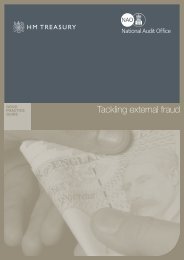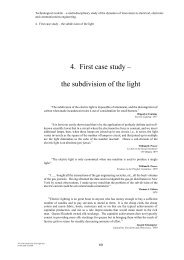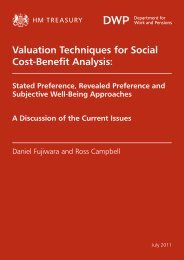Valuing Our Natural Environment Final Report ... - HM Treasury
Valuing Our Natural Environment Final Report ... - HM Treasury
Valuing Our Natural Environment Final Report ... - HM Treasury
Create successful ePaper yourself
Turn your PDF publications into a flip-book with our unique Google optimized e-Paper software.
<strong>Valuing</strong> <strong>Our</strong> <strong>Natural</strong> <strong>Environment</strong> – <strong>Final</strong> <strong>Report</strong> - Annex1<br />
But since the idea is to cover all points of view, and not to derive a representative sample,<br />
it may be reasonable to expect that repeated environmental applications to slightly<br />
different resources/issues (within a specific social/cultural context) could give similar<br />
results, in the sense of identifying similar general viewpoints on environmental,<br />
technological, economic, political spectra. This will depend on the similarity of issues<br />
covered in the statements though. In addition it may be less obvious precisely how any<br />
specific issue plays out in these spectra, suggesting that transferability across issues must<br />
be considered low.<br />
A1.2.5.9 Key uses – decision-making context(s)<br />
The Q-methodology approach is useful for initial analysis flagging up common issues or<br />
views amongst the public. This can help establish which policies are likely to meet with<br />
wide support or resistance. As described here, it is essentially a consultation technique,<br />
taking respondents' rankings, then analysing and presenting them independently of the<br />
respondents. It may be possible to implement Q-methodology in ways more under control of<br />
participants, for example, as part of participatory group work, allowing participants to<br />
write descriptions of identified typical sorts.<br />
A1.2.5.10 Key uses – coverage of natural environment<br />
Q-methodology can potentially be applied to any resource or issue and statements tend to<br />
range from very general to quite specific to a topic.<br />
A1.2.5.11 Discussion<br />
In applying Q-methodology it is likely to be unavoidable that researcher bias comes in<br />
through the distillation and choice of statements for sorting. Whether or not this has a<br />
strong influence on results may be uncertain. More significant bias may come in the choice<br />
of title and description for each of the ‘typical’ groups identified, which may carry<br />
unintended or unwarranted information cues to those using the results.<br />
It is also possible that the factor analysis is sensitive to precisely which sorts are included.<br />
Barry and Proops (1999) state that as few as 12 participants can generate statistically<br />
meaningful results, however the method in effect considers a large number of choices from<br />
each individual, and might be sensitive to which individuals are included or to small<br />
changes in individuals' sorts (e.g. swapping two statements could involve changing a large<br />
number of pairwise comparisons).<br />
A1.2.5.12 Consideration of distributional impacts<br />
With Q-methodology there is no inherent bias towards certain stakeholders; the idea is to<br />
cover all viewpoints and show “typical” types of view, without attempting to reveal what<br />
the relative frequencies of such views are in the population. However, some stakeholders<br />
(or points of view) might find it harder than others to produce rankings, which could lead to<br />
bias (e.g. if some stakeholders drop out/reject the method).<br />
A1.2.5.13 Advantages and disadvantages<br />
In applying in Q-methodology it is possible to carry out more than one Q-sort with the same<br />
sample, on different topics, thus improving the efficiency of the interviewing process. But<br />
most of the intensity rests with the researcher in any case. In particular, deriving<br />
statements from initial interviews, and distilling these down to the short list for Q-sorting,<br />
can be very time consuming. Barry and Proops (1999) note an advantage of Q-methodology<br />
is that all (or most) statements analysed come from (first-stage) participants, so the<br />
process is largely driven by participants' responses while still generating statistically<br />
rigorous results. However, from the point of view of participation, respondents do not<br />
control how the results are used, or even how they are described. Secondly, there is no<br />
direct measurement of the relative proportions of different ‘types’ in the population,<br />
although this can be achieved to some extent by comparing back to the respondents (but<br />
note that then the low sample size becomes statistically problematic, especially if sampling<br />
has not been random).<br />
eftec A48<br />
December 2006





![AIRTO [Professor Dr Brian Blunden] - HM Treasury](https://img.yumpu.com/15492848/1/184x260/airto-professor-dr-brian-blunden-hm-treasury.jpg?quality=85)










